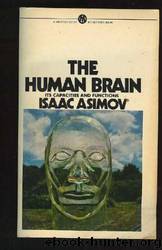The Human Brain: Its Capacities and Functions by Isaac Asimov;Anthony Ravielli

Author:Isaac Asimov;Anthony Ravielli
Language: eng
Format: mobi
Tags: Psychology, Endocrinology, Medical, General, Brain, science, Neuroscience, Nervous System
ISBN: 9780451628671
Published: 2011-06-18T12:59:53+00:00
132 THE HUMAN BRAIN
Epilepsy is not very uncommon, since about i in 200 suffer from it, though not necessarily in its. extreme form. It has a fascinating history. Attacks of grand mal are frightening and impressive, particularly in primitive societies (and some not so primitive) that do not understand what is taking place. During the attack, the epileptic's muscles are clearly not under his own control and it is easy to conclude that his body has been momentarily seized by some supernatural being. (Hence, the fit is considered a "seizure" and thus the name "epilepsy" arises.) Some famous people, including Julius Caesar and Dostoyevsky, have been epileptics.
The supernatural being may be conceived of as an evil demon, and the existence of epileptic seizures are partly to blame for the belief, even down to modern times, in demonic possession. The epileptic may be felt to have gained supernatural insights into the future as a result of his intimate relationship with the supernatural. A Delphic prophetess was always more impressive if she experienced (or counterfeited) an epileptic fit before delivering her prophecy. Modern mediums, during spiritualistic seances, are careful to writhe convulsively. To the Greeks epilepsy was "the sacred disease." Hippocrates, the "father of medicine" (or possibly some disciple), was the first to maintain that epilepsy was a disease like other diseases, caused by some organic failing, and potentially curable without recourse to magic.
The EEG is characteristic for each variety of epilepsy. Grand mal shows a pattern of high-voltage fast waves; petit mal, fast waves with every other one a sharp spike; psychomotor attacks, slow waves interspersed by spikes. The brain-wave pattern can be used to detect subclinical attacks that are too minor to be noticed otherwise. It can also be used to follow the reaction of patients to treatment by noticing the frequency and extent of these abnormal patterns.
Other uses of EEG are in the process of being developed. Thus, the brain, because of its critical need for oxygen and glucose, is the first organ to lose function in a dying patient. With
OUR CEREBRUM 183
modern techniques of resuscitation, it is not impossible that patients may be revived while the heart is still beating but after the higher centers of the brain are irretrievably gone. Life under those conditions is scarcely to be called life, and it has been suggested that loss of EEG rhythms be considered as marking death even though the heart is still struggling to beat.
EEG may be useful in diagnosing and even in learning to understand various psychotic states, which is something I shall come back to in Chapter 14.
THE BASAL GANGLIA
The portion of the cerebrum beiow the cortex is, as mentioned earlier in the chapter, largely white matter, made up of myelin-sheathed nerve fibers. Just above the various ventricles making up the hollow within the brain, for example, is a tough bridge of white matter, the corpus callosum (kawr'pus ka-loh'sum; "hard body" L), which binds the two cerebral hemispheres together (see illustration, p. 165). Nerve fibers cross
Download
This site does not store any files on its server. We only index and link to content provided by other sites. Please contact the content providers to delete copyright contents if any and email us, we'll remove relevant links or contents immediately.
The Art of Thinking Clearly by Rolf Dobelli(9908)
The 5 Love Languages: The Secret to Love That Lasts by Gary Chapman(9273)
Mindhunter: Inside the FBI's Elite Serial Crime Unit by John E. Douglas & Mark Olshaker(8699)
Becoming Supernatural by Dr. Joe Dispenza(7831)
The Road Less Traveled by M. Scott Peck(7275)
Nudge - Improving Decisions about Health, Wealth, and Happiness by Thaler Sunstein(7238)
Mastermind: How to Think Like Sherlock Holmes by Maria Konnikova(6936)
Enlightenment Now: The Case for Reason, Science, Humanism, and Progress by Steven Pinker(6869)
Win Bigly by Scott Adams(6824)
The Way of Zen by Alan W. Watts(6288)
Factfulness: Ten Reasons We're Wrong About the World – and Why Things Are Better Than You Think by Hans Rosling(4486)
The State of Affairs by Esther Perel(4483)
Gerald's Game by Stephen King(4371)
Man's Search for Meaning by Viktor Frankl(4266)
The Confidence Code by Katty Kay(4033)
Thinking in Bets by Annie Duke(3995)
The Worm at the Core by Sheldon Solomon(3325)
Hidden Persuasion: 33 psychological influence techniques in advertising by Marc Andrews & Matthijs van Leeuwen & Rick van Baaren(3290)
Enlightenment Now by Steven Pinker(3271)
